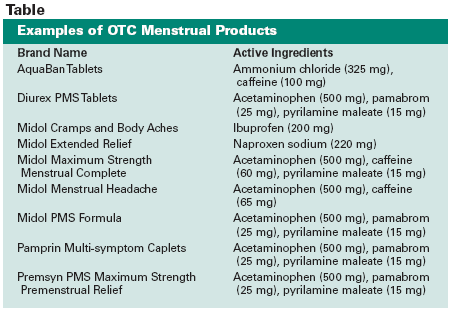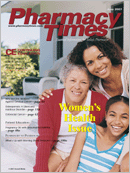Publication
Article
Pharmacy Times
Premenstrual Syndrome Products
Author(s):
Premenstrual syndrome, commonly referred to as PMS, is characterized by both physical and emotional symptoms that can manifest themselves during the luteal phase of a woman or girl?s menstrual cycle.1 Although the exact cause of PMS is unknown, it is, however, believed that normal ovarian function, as well as fluctuations in the levels of estrogen and progesterone, may be considered the trigger for the symptoms associated with PMS.1-3
According to a report from the American College of Obstetricians and Gynecologists, ~85% of menstruating females experience =1 PMS symptoms.4 The incidence and severity of PMS varies among females: 40% consider their symptoms bothersome; another 10% to 15% consider their symptoms severe; and 3% to 5% feel that their symptoms negatively impact their quality of life.1 Premenstrual dysphoric disorder (PMDD) is a more severe form of PMS experienced by ~5% of females.1
The symptoms can occur between 5 and 11 days prior to the start of menses and typically cease on initiation of menses or shortly thereafter. Common symptoms include the following1-4:
- Headache
- Bloating/weight gain
- Abdominal pain
- Backache
- Tenderness of the breasts
- Swelling of the ankles, feet, and hands
- Episodes of fatigue
- Acne
- Mood swings
- Irritability
- Appetite changes or cravings
- Difficulty concentrating
- Depression
Treatments for PMS
Between 20% and 50% of females use OTC products for symptomatic relief.1 Treatment of the symptoms of mild-to-moderate PMS typically involves nons-teroidal anti-inflammatory drugs (NSAIDs), diuretics, vitamins, and minerals, as well as dietary and lifestyle modifications. Combination products are available that contain an analgesic (acetaminophen), a diuretic (pamabrom), and an antihistamine (pyrilamine maleate; Table). Patients should be aware that drowsiness may be associated with the use of combination products containing antihistamines.
Diuretic products?which may contain ammonium chloride, caffeine, or pam-abrom?are used for treating the water retention and bloating that are often associated with PMS. Patients with a history of peptic ulcer disease or anxiety/ insomnia disorders and those using monoamine oxidase inhibitors or other xanthine derivatives should not use products containing caffeine or pam-abrom. In addition, the use of ammonium chloride is contraindicated in individuals with renal or hepatic impairment.1
Other Therapies
Analgesics
Analgesics (acetaminophen or NSAIDs) may reduce physical symptoms such as headache, cramping, and back pain when taken for 1 week prior to and during the first days of menses.1 Patients should be advised to take only the recommended dose and to be aware of the adverse effects associated with their use.
Vitamin E
Vitamin E has been shown to ease the discomfort associated with breast tenderness.1 Patients should take only the recommended amount of 400 international units daily.
Calcium
Studies have shown that calcium may ease emotional and behavioral symptoms as well as physical symptoms.1,2,4 Patients should take 1200 mg daily in divided doses and take no more than 500 mg per dose. Because calcium may cause gastric upset or constipation, it should be taken with food.
Magnesium
A study has demonstrated that a daily dose of 360 mg of magnesium taken during the luteal phase may provide some relief from PMS symptoms. Some theories suggest that magnesium deficiency may lead to symptoms of irritability associated with PMS.1 Patients should be advised to take 360 mg of magnesium daily during the premenstrual phase only. Magnesium may cause diarrhea in some patients.
Pyridoxine (Vitamin B6)
Vitamin B6 also has been used for treating PMS symptoms, such as irritability, fatigue, bloating, and depression. Doses should be limited to 100 mg daily to reduce the incidence of neuropathy.1,2,4
Patient Counseling
Selection of treatment for PMS symptoms should be individualized and should depend on the type and severity of the patient?s symptoms. Other factors are medical history, allergy history, and current medication profile (including OTC drugs, nutritional supplements, or alternative medications).
Pharmacists can identify possible drug interactions and contraindications, as well as ascertaining whether the use of OTC medications is appropriate. It is important to counsel women whose symptoms do not improve after the use of OTC products?or those with more severe symptoms?to seek medical advice from their primary health care provider. In addition, patients with preex-isting medical conditions should see their primary care provider before taking any PMS products.
Pharmacists should ensure that patients understand the proper use of these products and the adverse effects associated with them. In addition, pharmacists can make recommendations about nondrug measures, such as using heat wraps for menstrual cramp relief; relaxation techniques; an exercise routine; eating a balanced diet and avoiding or limiting intake of salt, caffeine, or alcohol at least 7 to 14 days before menses; getting sufficient rest; and avoiding stress.

References
1. Shimp LA. Disorders related to menstruation. In: Berardi RR, Kroon LA, McDermott JH, et, eds. Handbook of Nonprescription Drugs. 15th ed. Washington, DC; American Pharmacists Association; 2006. Chapter 9:163-172.
2. Premenstrual Syndrome. US Department of Health and Human Services Web site. Available at: www.womenshealth.gov/faq/pms.htm.
3. Premenstrual Syndrome (PMS). Merck Manuals Online Medical Library Web site. Available at: www.merck.com/mmpe/sec18/ch244/ch244g.html.
4. Premenstrual Syndrome. Medline Plus Web site. Available at: www.nlm.nih.gov/medlineplus/ency/article/001505.htm.







